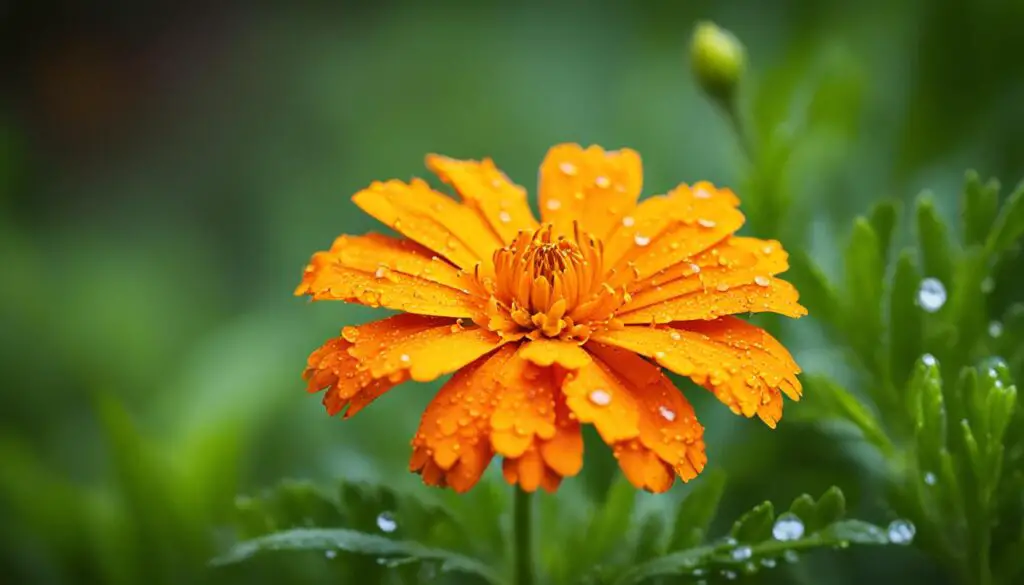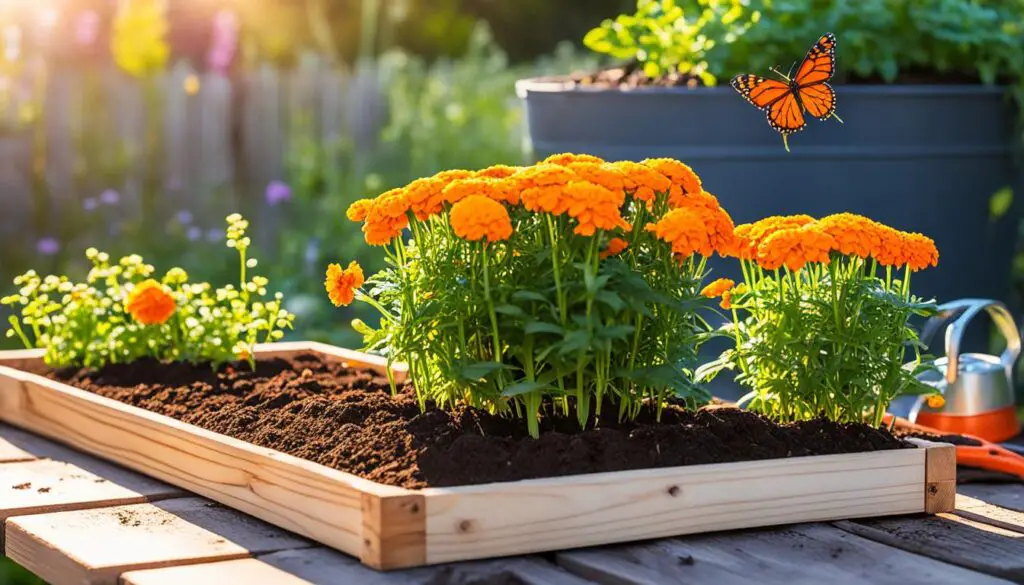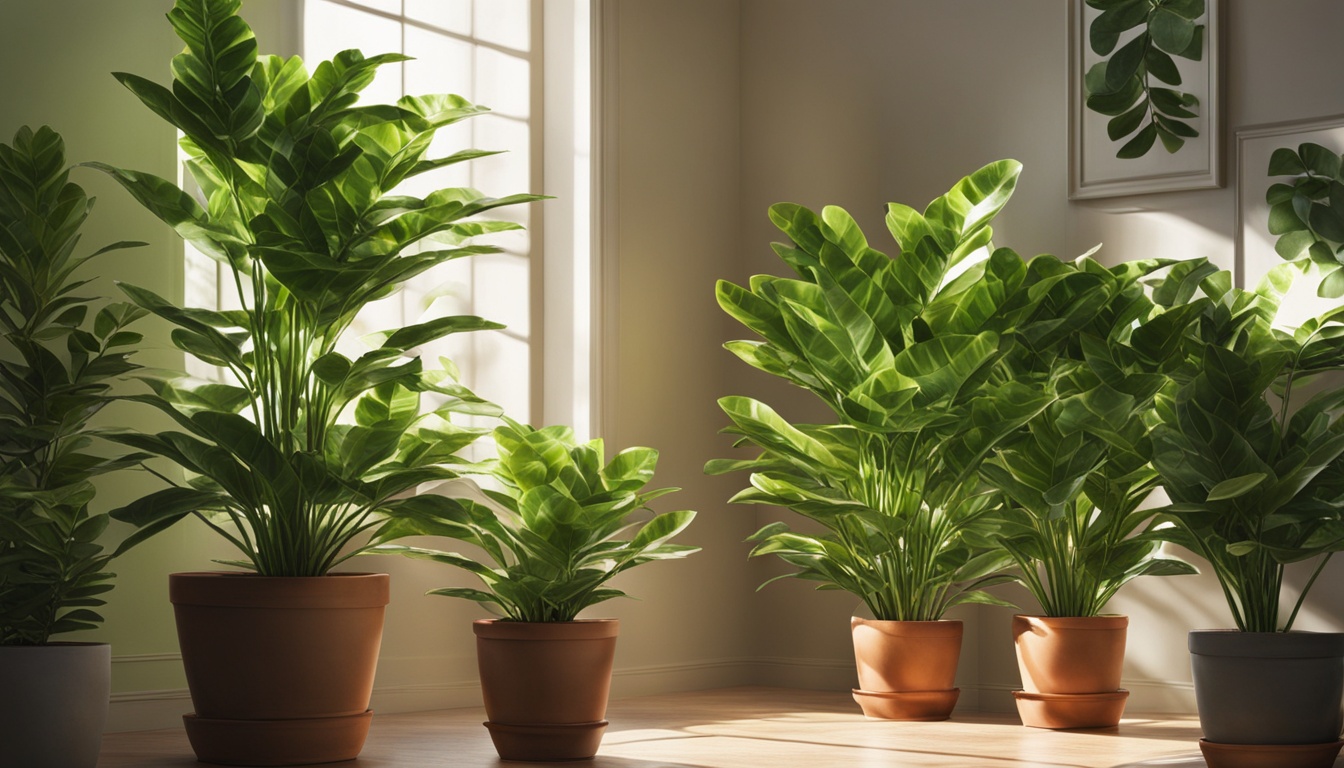Learn how to grow vibrant marigolds in your garden. These annuals bring color and help keep pests away.
They also attract pollinators. I’ll share tips for planting and caring for marigolds to keep them healthy all season.

Key Takeaways
- Marigolds (Tagetes) are known for attracting pollinators and deterring pests in the garden.
- There are three main types of marigolds – African, French, and Signet – that vary in size and growth habits.
- Marigolds thrive in full sun, well-drained soil, and with regular watering, especially when establishing their root systems.
- Proper spacing, deadheading, and pest management are key for optimal marigold growth and extended blooming.
- Marigolds come in a range of vibrant colors and can be used as companion plants, cut flowers, and more.
About Marigolds: Vibrant Annuals for Gardens
Marigolds are the stars of summer and autumn gardens, adding gold, copper, and brass colors.
They come in over 50 species, with the tall African marigolds, the bushy French marigolds, and the small signet marigolds being the most common. Each type has its own special features that make them great for any garden.
Tagetes erecta (African Marigolds)
African marigolds stand tall, growing from 1 to 4 feet high. Their big flowers can be up to 5 inches wide, making a big impact in the garden.
They are known for their bright orange and yellow colors, sometimes with red, gold, copper, or brass touches.
Tagetes patula (French Marigolds)
French marigolds are a bit shorter, reaching 6 to 12 inches tall and wide. Their flowers can grow up to 2 inches wide, offering a burst of color.
They come in various colors like yellow, orange, and even bicolor patterns.
Tagetes tenuifolia (Signet Marigolds)
Signet marigolds are the smallest, reaching up to 12 inches tall and wide. Despite their size, they have edible flowers that add color and flavor to salads and garnishes.
For centuries, marigolds have been loved for their beauty and pest-repelling qualities. These annuals grow in all zones and bloom from late spring until the first frost. They are a must-have for any garden.
| Marigold Type | Height | Flower Size | Characteristics |
|---|---|---|---|
| African Marigolds (Tagetes erecta) | 1 to 4 feet | Up to 5 inches | Tall, robust plants with large, full flowers in shades of orange and yellow |
| French Marigolds (Tagetes patula) | 6 to 12 inches | Up to 2 inches | Compact, bushy plants with double flowerheads in a range of colors |
| Signet Marigolds (Tagetes tenuifolia) | Up to 12 inches | 1 inch | Petite plants with edible, daisy-like blooms |
Grow A Marigold and Care: Step-by-Step Guide
Growing marigolds is easy and fun. Whether you’re planting Marigold Planting seeds or moving seedlings, these annuals need simple care to flourish. They thrive all season with a little attention.
First, prepare the soil for Marigold Planting. Pick a spot with soil that drains well and is a bit fertile. Marigolds do best in soil that’s a bit acidic to neutral, with a pH of 6.0 to 7.0. Add Miracle-Gro® Garden Soil for Flowers to make sure the soil has the right nutrients.
- Sow marigold seeds in the garden after the last frost or start them indoors 4-6 weeks early for a head start.
- Marigold Watering is key – water often, but avoid overhead watering to stop fungal diseases. Check the soil and water when the top inch feels dry.
- Marigold Fertilizing isn’t needed too much. Use a water-soluble Miracle-Gro® Bloom Booster Flower Food about a month after planting for a nutrient boost.
To keep marigolds blooming, don’t forget to Marigold Deadheading. Remove dead flowers often. This encourages the plant to make more buds for a long, bright display.
Marigold Maintenance is easy. Adding mulch around the plants helps keep the soil moist and stops weeds. Watch out for pests like Japanese beetles and use organic ways to control them.
With a little care, marigolds will fill your garden with bright, fragrant flowers all season. Enjoy them as borders, in containers, or as plants that keep pests away naturally.

Marigold Varieties: Choosing the Perfect Blooms
Marigolds come in many sizes, shapes, and colors for any garden. You can find everything from the small, bushy French marigolds to the tall, striking American or African types. Let’s look at some popular marigold types to help you pick the best for your garden.
French Marigold Varieties
French marigolds are small and delicate, with beautiful double blooms in yellow, orange, and maroon.
The ‘Little Hero’ series is compact and bushy, great for borders. ‘Bonanza’ and ‘Janie’ varieties have flowers like carnations on strong stems. These small marigolds are great companions, keeping pests away and adding color to your garden.
American/African Marigold Varieties
For a big impact in your garden, try the tall American or African marigolds. The ‘Jubilee’, ‘Gold Coin’, and ‘Safari’ series have big, single flowers on tall stems. They’re perfect for cut flower arrangements.
These plants can grow up to 5 feet tall, with flowers in golden yellow, orange, and red. They’re great for making a beautiful border or filling vases with bright flowers.
FAQ
What are the key steps to growing thriving marigolds?
To grow healthy marigolds, start by preparing well-draining, moderately fertile soil. Sow seeds directly in the garden or transplant seedlings. Water them regularly to prevent fungal issues.
Marigolds don’t need a lot of fertilizer. But, a layer of mulch can help keep the soil moist. Make sure to deadhead spent flowers to encourage more blooms.
What are the different types of marigolds I can grow?
There are several types of marigolds you can grow. The tall African marigolds (Tagetes erecta) and the smaller French marigolds (Tagetes patula) are popular. Then, there are the petite signet marigolds (Tagetes tenuifolia).
Each type has its own unique features. African marigolds have large, full flowers. Signet marigolds have delicate, anemone-like blooms.
How can I choose the perfect marigolds for my garden?
Think about your garden’s needs and what you like when picking marigolds. French marigold varieties like ‘Little Hero’, ‘Bonanza’, and ‘Janie’ are great for small spaces. They have compact, bushy plants with double carnation-like blooms in various colors.
The taller American or African marigolds, such as ‘Jubilee’, ‘Gold Coin’, and ‘Safari’, are perfect for cutting. They have large, bold flowers.
How do marigolds help deter pests in the garden?
Marigolds are great companion plants that keep pests away. Their strong scent repels insects like aphids, nematodes, and even rabbits. This makes them a valuable addition to any garden.
When is the best time to plant and harvest marigolds?
Marigolds are warm-weather annuals. The best time to plant them is after the last frost in spring. You can sow them directly in the garden or start them indoors and then transplant them.
For a longer blooming season, deadhead spent flowers often. This encourages more buds to grow. Marigolds can be harvested for their flowers, leaves, and seeds. The seeds can be used in cooking or for medicinal purposes.



